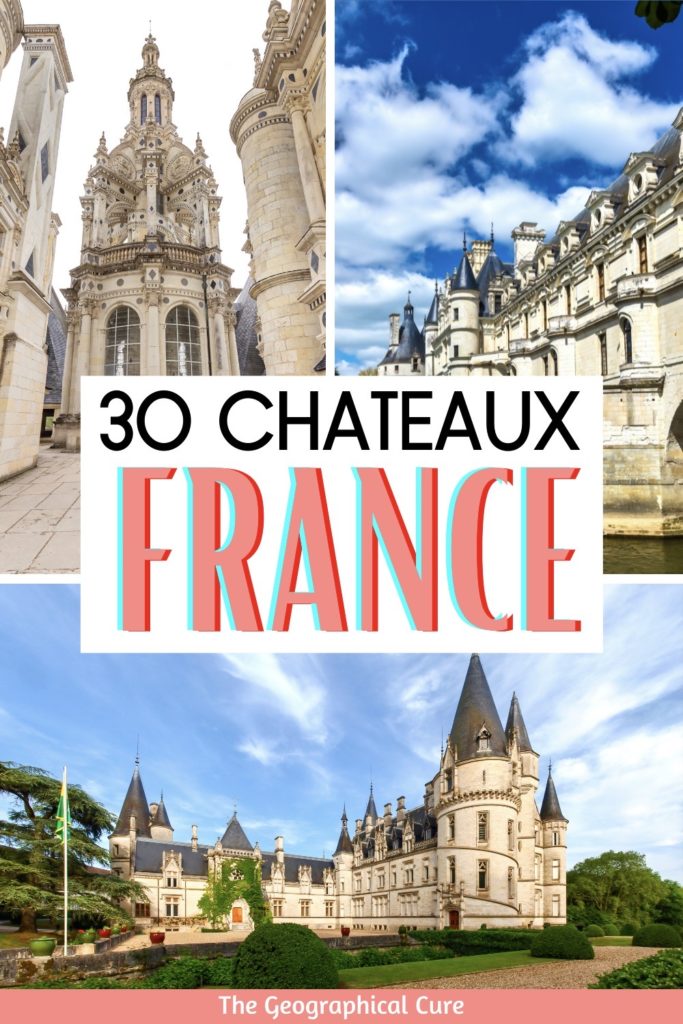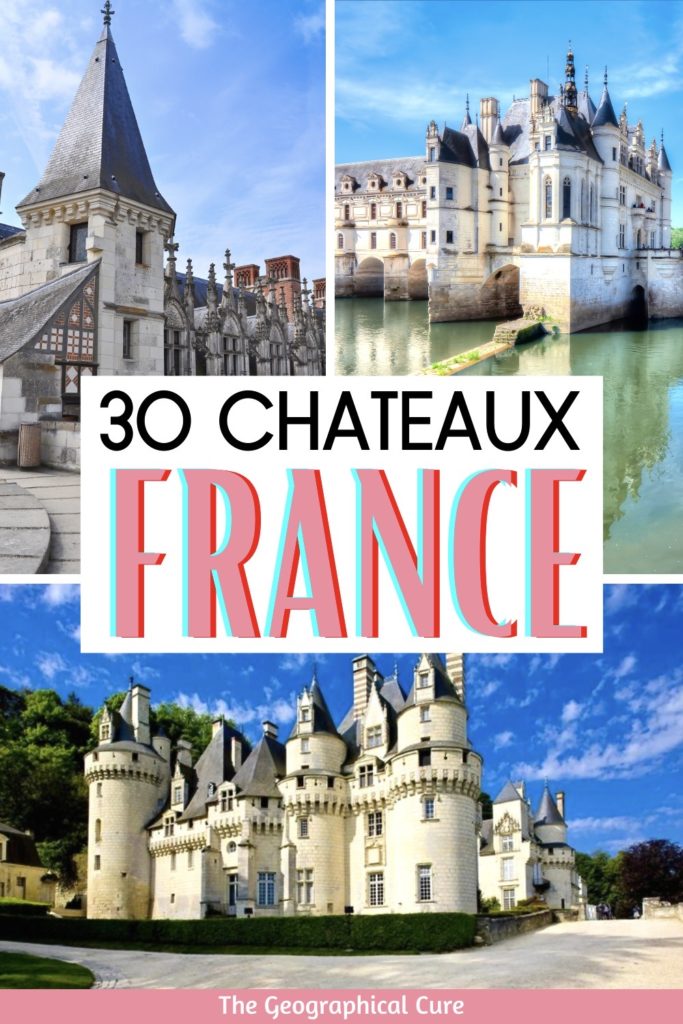Are you in search of a beautiful chateaux to visit in France?
Look no further. Here’s my guide to the 30 most beautiful chateaux in France.
France conjures up visions of fairytale castles, stately Renaissance architecture, and ribbons of verdant vineyards. This is where France is the Frenchest.
Some of these glorious chateaux are right outside Paris, and make the perfect day trip from the City of Light.
Some chateaux are scattered throughout the Loire Valley, which is known as “The Garden of France” and the “Valley of the Kings.”
30 Beautiful Chateaux in France
Here are my pick for the most beautiful and magical chateaux in France.
1. Chateau Vaux-le-Vicomte
Chateau Vaux-le-Vicomte was Versailles before Versailles existed. The privately owned chateau is the one of the most beautiful chateaux in France.
When Princess Elizabeth visited in 1948, she pronunced it “more beautiful than Versailles!” Built between 1656-61, it’s a fine example of French Baroque architecture with elaborate gold paneled halls.
In fact, Vaux-leVicomte was the inspiration for Versailles. The chateau was originally owned by the ill-fated Nicholas Fouquet, Louis XIV’s finance minister.
In 1661, against his friends’ advice, Fouquet invited the king and his entourage to a luxurious dinner reception.
Three weeks later, jealous of such grandeur, a peeved Louis XIV ordered Fouquet’s arrest and seized the estate. He stole the exquisite statues and tapestries for Versailles. But otherwise left Vaux-le-Vicomte intact.
Click here to book a guided day tour from Paris to the chateau.
2. Chateau de Fontainebleau
Chateau de Fontainebleau is a ravishing UNESCO site and one of France’s must visit chateaux. The rambling chateau boasts 800 years of royal patronage.
The NYT calls Fontainbleau “the single greatest assemblage over time of French architecture and decor still in its original state.”
It’s a rare royal residence that escaped from the war time ravages of the French Revolution.Francois I is most associated with Fontainebleau and he significantly expanded it.
The highlights are the Royal Apartments, Marie Antoinette’s boudoirs (the Turkish Bedroom and the Silver Bedroom), the Papal Apartment, and the grand Francois I Gallery.
You can visit Fontainebleau (along with Vaux-le-Victome) on a small group guided day tour from Paris. You can also visit the chateau and take a hot air balloon ride.
3. Chateau de Chambord
Chateau de Chambord is the big daddy of Loire Valley chateaux and one of the most beautiful chateaux in France. Building started on this massive Renaissance chateau in 1519.
Commissioned by Francois I, a lowly hunting lodge was transformed into a monument to royalty and royal sport. It’s rumored that Leonardo da Vinci influenced some of the chateau’s architectural elements.
The chateau is laid out as a keep in the shape of a cross with four towers, 400 spikey sculpted columns, two wings, and over 400 rooms. The highlight is its mind- boggling double helix staircase.
Twin staircases intertwine without actually touching. The rooftop offers breathtaking views over the valley.
Here’s my complete guide to Chateau de Chambord, with tips for visiting. Click here for an entrance ticket for Chateau Chambord. Click here to book a 2 hour guided tour.
You can also tour the chateau and do some wine tasting. Or visit the chateau along with Chenonceau on a full day tour from Paris. If you’re looking for an incredible place to stay near Chambord, check out the stunning Relais de Chambord.
4. Chateau de Chenonceau
Built in the 16th century, the Chateau de Chenonceau is the most famous and romantic of the Loire Valley chateaus. It spans the River Cher with picturesque palace arches for boats to glide under.
Chenonceau housed and was influenced by many famous women over the centuries — Diane de Poitiers, Catherine de’ Medici, and Louise Dupin. Hence, it’s nicknamed the “Ladies Chateau.”
Poitiers added the five arch bridge to span the River Cher. Medici transformed the Poitiers’ bridge into a two story promenade and ballroom gallery, which resembled the Ponte Vecchio in Florence Italy. Chenonceau was also the site of Francis II’s marriage to Mary Queen of Scots.
Highlights of the meticulously maintained chateau are the lavishly decorated ceilings, the ornate chapel, the Grand Gallery, the bedroom of Diane de Poitiers, and the Medici Gallery (now a museum). The museum houses Old Master paintings by Rubens, Pouissin, and Tintoretto.
Click here to pre-book a ticket. Click here to book the iconic hot air balloon ride over Chenonceau.
You can also visit Chenonceau and Chambord on a guided day trip from Paris. You can also book a guided tour from Paris that includes lunch at a private castle.
5. Chateau de Villandry
This lovely Renaissance Chateau de Villandry was completed in 1536. If you have a passion for gardens, this is the chateau for you.
Villandry is a chateaux in France that’s renowned for its beautiful landscaped gardens. There are acres of decorative ponds, arbors, a maze, fruity trees, vineyards, and themed gardens.
You get a bird’s eye view of the gardens from the chateau’s only medieval remnant, the donjon of the keep.
You can visit Villandry and two wineries on a guided day trip from Tours.
6. Chateau d’Angers
Chateau d’Angers was the fiefdom of the powerful dukes of Anjou and the Plantagenets.
The formidable chateau is an impressive black and stone affair, ringed by battlements and punctuated by 17 watch towers. The “black” stone is actually blue schist.
The chateau houses one of France’s great treasures — the 14th century Apocalypse Tapestry, the Tenture de l’Apocalypse.
Louis I, Duke of Anjou, commissioned the set of tapestries from Hennequin de Bruges in 1375. The 300+ foot tapestry depicts the story of Judgment Day.
>>> Click here to book a fast track ticket
7. Royal Chateau de Blois
The royal Chateau Royal de Blois was the favorite residence (and architectural project) of 7 kings and 10 queens of France.
With its various Medieval, Gothic, Renaissance, and Classical facades, the chateau reflects all of France’s great architectural periods. In 1429, Joan of Arc visited the castle to be blessed before doing battle with the English.
The Chateau de Blois was fully restored in the 19th century. It also houses the Blois Fine Arts Museum, with approximately 35,000 art works from the 16th and 17th century. It boasts masterpieces by Ingres, Rubens, and Boucher.
Other Chateau Blois highlights are: (1) loggia staircase, decorated with Francois I’s salamanders; (2) the Studiolo, where Catherine de Medici kept her stash of poisons; and (3) the king’s apartments.
It was in these apartments that Henry III murdered his arch rival Duke Henry I of Guise.
Click here to book a skip the line entrance ticket. You can also visit Blois and other chateau on a guided day tour from Paris.
There’s also a beautiful hotel 20 minutes from both Blois that you should check out, the Domain des Hauts de Loire.
8. Chateau de Cheverny
Built in 1625-34, the Chateau de Cheverny represents the zenith of French classical architecture. One of the most beautiful chateaux in France, it’s a perfectly proportioned tour de force of symmetry and aesthetic order.
The chateau is so orderly and stately that it’s not quite as appealing to me as some of the other more romantically styled chateaux.
Inside, the Chateau de Cheverny is sumptuously furnished with many works of art and tapestries. The dining room murals famously depict the story of Don Quixote.
Chateau de Cheverny inspired Moulinsart Hall in the TinTin comic books, which you may remember from your childhood.
Cheverny is also home to 100 hunting dogs. They’re a special breed, or cross-breed, of English fox hounds and French Pointer dogs. Their daily feeding is at 11:30 am, if you want to see them lunge at their food on cue.
Click here to book a skip the line entrance ticket. You can see Cheverny (+ Chambord and Chenonceau) on a full day guided day tour from Paris.
9. Chateau de Chaumont
The beautiful Chateau de Chaumont combines a medieval facade with 19th century furnishings inside. Construction began circa 1465 and continued until 1510.
The chateau has elaborate gardens and hosts a “Festival International des Jardins” in high season.
Catherine de Medici purchased the chateau after her husband Henry II died. There, she entertained various astrologers, including Nostradamus.
In 1559, Catherine kicked Diane de Poitiers, Henry II’s mistress, out of the Chateau de Chenonceau and gave her the fortress-like Chaumont instead. She also made Diane hand over the crown jewels Henry had given her.
In 1875, the heiress Princess de Broglie purchased and renovated the chateau. Rather high maintenance, she also had the entire village razed and rebuilt.
You can book a guided day tour to visit the chateau and its gardens.
10. Chateau d’Amboise
The royal chateau of Amboise is a Renaissance jewel, with a taste of Italy and some medieval gargoyles thrown in for good measure.
Amboise features the Loire Valley’s iconic gray slate cone-shaped rooftops. Designed by Italian master masons, Chateau Amboise is known as the “First Italianate Palace in France.”
Chateau d’Amboise is perched on a rocky outcrop overlooking the town of Amboise.
The chateau was the childhood home of luminaries such as King Charles VIII, Francois I, and Mary Queen of Scots.
At the invitation of Francois, Renaissance artist Leonardo da Vinci was a guest at the chateau. Da Vinci lived and worked at his own Amboise home, Close Luce.
It was connected to the chateau by an underground tunnel. Leonardo brought three of his favorite paintings along with him to Amboise — Sainte Anne, Saint Jean Baptiste, and a special little piece called the Mona Lisa.
READ: Guide To all of Leonardo da Vinci’s Paintings
Da Vinci is buried in the chateau’s Chapelle St-Hubert, also called, naturally, the DaVinci Chapel.
Click here to book a skip the line entrance ticket.
11. Chateau de Maisons-Laffitte
Maison-Lafitte is a 17th century beauty, located northwest of Paris. It was built by renowned architect Francois Mansart between 1630-35.
The chateau is a milestone in French cultural history because it was one of France’s first Baroque style palaces.
Nobody in France had seen anything like it. When the chateau was finished in 1651, people would travel long distances just to catch a glimpse.
The chateau has commanding views of the forest of Saint-Germain-en-Laye and the Seine.
12. Chateau de Sceaux
Sceaux Castle is a dreamy little chateau-castle that be reached easily from Paris. The chateau was originally built in 1670. But it was demolished during the French Revolution.
In 1856, it was re-built by the Duke of Treviso. The castle lies in a beautiful estate with a cherry blossom orchard and orangery, which makes a spring visit enticing.
Like Versailles and Vaux-le-Vicomte, the gardens of Sceaux were designed by master landscaper André Le Nôtre. There are fountains, green spaces, and trees galore. And the grounds are free to visit.
Sceaux was one of the filming locations for the BBC series Versailles. You can take virtual tour of the chateau’s beautiful interiors on YouTube here.
13. Chateau de Monte-Cristo
Literature lovers will adore the swishy pleasure house of the famed novelist Alexandre Dumas. In 1847, with characteristic panache and elan, Dumas unveiled a dashing new estate to his coterie of friends and fans.
It was one of the greatest architectural follies of its time — a miniature Renaissance chateau and a Gothic house set in Le Port-Marly outside Paris.
Naturally, Dumas christened the chateau the “Chateau de Monte-Cristo” and the Gothic house the “Chateau D’If.” The novelist Honore de Balzac described the duo as “one of the most delicious follies ever created … the most royal sweetbox in existence.”
The Chateau de Monte-Cristo is now a house museum dedicated to Dumas’ life and novels. Here’s my complete guide to visiting the Chateau de Monte-Cristo.
You can visit the chateau on a private day tour from Paris.
14. Chateau D’Azay-le-Rideau
This petit chateau is one of France’s most romantic hidden gems. Situated on an island in the middle of the Indre River, this moat-ringed chateau dazzles with fanciful turrets and decorative stonework.
Honoré de Balzac dubbed it a “multifaceted diamond set in the River Indre.”
The chateau’s most famous feature is its open loggia staircase. The staircase is Italianate in style and overlooks the central courtyard. And it’s decorated with salamanders and ermines, symbols of Francois I and Queen Claude.
Just along the river from Azay-le-Rideau castle is the hidden gem Chateau de l’Islette, where you can escape the crowds. Its privately owned, but open to the public. Far from Paris, during the 1890s, l’Islette was the secret love nest of two great French sculptors Camille Claudel and Auguste Rodin.
Click here to book a ticket to the chateau. Click here to book a tour of the chateau with Villandry and a wine tasting.
15. Chateau de Pierrefonds
In 1857, Napoleon III hired the famed architect Eugene Viollet-le-Duc to rebuild the romantic ruins of Pierrefonds Castle. Napoleon III longed for a lavish castle, fit for a king and evoking a medieval fantasy.
Inspired by Coucy Castle, one of my favorite French ruins, Viollet-le-Duc sought to maintain an equilibrium between a fortified palace with beautiful state rooms and a residence.
The architect used ornamental and architectural references from the middle ages and new construction materials.
The rooms are recreated in vibrant rich colors as they would have appeared in the Middle Ages, with medieval motifs like St. George and the Dragon.
Here’s my complete guide to Pierrefonds Castle. Click here to book a skip the line entrance ticket.
16. Chateau de Coucy
If you fancy a romantic ruined chateau in France, the Chateau de Coucy is perfect. Chateau de Coucy was the greatest castle of the middle ages.
The Chateau was made famous as the home of the fictional Enguerrand de Coucy VII, the star of Barbara Tuchman’s magnificent novel The Distant Mirror.
During its heyday, the chateau was famous for the size of its donjon and the pride of the Coucy lords. They had a bold motto, which translates to “I am not king, nor prince nor duke nor count; I am the Lord of Coucy.”
In 1400, after Enguerrand’s death, the Duke of Orleans bought the chateau. In 1498, the chateau became Crown property. During the French Revolution, it was transformed into a prison. In 1829, King Louis-Philippe purchased the chateau.
It was renovated by Viollet-le-Duc, the famous restorer of Notre Dame, Carcassonne, and Pierrefonds.
Here’s my complete guide to visiting the magnificent ruins off Coucy Chateaux.
17. Chateau de Fere
Reminiscent of Chateau de Chenonceaux, the Chateau de Fere is now an atmospheric 5 star luxury hotel. It’s delightful. I know; I stayed there.
The hotel sits next to the evocative remains of a 13th century fortified castle that fell into ruin in the 17th century.
Formerly a wing of the old castle, the chateau hotel was restored in 1863 and now nestles amidst flourishing woodland and manicured gardens.
You can take a virtual tour on the hotel’s website.
18. Chateau de Chantilly
This imposing palace is a 19th century version of Renaissance architecture. It was built by Henri d’Orléans, son of the last king of France Louis-Philippe.
He was a great patron of the arts and made Chantilly the showcase for his masterpieces.
Andre Le Notre designed the chateau’s gardens. The 18th century stables are original and now contain an equestrian museum.
Inside, you’ll find Chantilly’s crown jewel, the Musée Condé. The museum is chock full of precious art, sculpture, and a breathtaking library with medieval manuscripts.
The most valuable pieces are the Renaissance paintings by Raphael, Botticelli, and Lippi.
Click here to book a skip the line entrance ticket.
19. Chateau de Vincennes
Lying in the eastern suburbs of Paris is the 14th century Chateau de Vincennes. The chateau began life as as a royal hunting lodge in the 12th century. During the 13th century, the lodge was transformed into a larger, palatial estate for the French kings.
In the 14th century, the venerable building you see today was reconstructed, renovated, and modernized. It became the primary royal seat until Versailles was completed.
When the 52 foot Donjon was added, Chateau de Vincennes became the tallest medieval fortified structure in Europe.
The chateau is wholly intact with a keep, dungeon, moat, and fortified concentric walls.
>>> Click here to book a priority entrance ticket
20. Chateau de Versailles
The Chateau de Versailles is France’s most famous and beautiful chateau.
The UNESCO-listed palace was once the center and cultural heartbeat of Europe, until the French Revolution. The Sun King Louis XIV used Versailles as his royal seat from 1682 to 1789.
The Palace of Versailles is ornately decorated, to say the least. It’s massive, flashy, and very, very gold. The opulence is overwhelming. Even the bathrooms are gold plated.
As exemplifies the Baroque style, the palace was decorated with gilding, stucco, arabesques, frescoed vaulted ceilings, mirrors, and tromp l’oeil effects. The king’s apartments were in the center, because the world revolved around him.
Aside from Louis XIV, Versailles’ most famous occupant was Marie Antoinette. The queen made major changes to the palace’s decor in the 18th century.
Louis XVI built her the Petit Trianon, a little Neo-Classical palace on the grounds. Marie Antoinette hired two architects to create a pastoral fantasy for her, the Hameau de la Reine. The hameau cottages looked like a rural village, but inside hey were decked out.
Versailles may be the most popular day trip from Paris. You’ve got to be organized to visit and beat the crowds.
Click here to book a full access skip the line ticket. You may also want to book a guided tour of the magnificent palace. There are many different options:
- a 1.5 hour small group guided tour
- a 2.5 hour small group tour
- a 4 hour guided tour from Paris
- a 7 hour small group tour from Paris that includes Marie Antoinette sites
- an 8 hour private tour from Paris that includes Marie Antoinette sites
21. Chateau de Beauregard
Chateau de Beauregard is a hidden gem in the Loire Valley. It’s just a 15 minute drive from Chateau Cheverny. Like Chambord, Beauregard was a favorite hunting lodge of Francoise I.
The chateau’s highlight is the 17th century Renaissance style Portrait Gallery. In it, you’ll find 327 paintings of European royalty. They include recognizable figures such as Cardinal Richelieu, Francis Drake, Henry VII, Ann Boleyn, and a score of French kings.
When you’re done examining The Who’s Who, escape to the landscaped park. Beauregard has one of the best rose gardens in the Loire Valley.
There’s also a Portrait Garden, with facts sheets and pictures hanging from trees. It’s the brainchild of landscape architect Gilles Clement.
22. Chateau du Clos Luce
If you’re a fan of famed Renaissance artist Leonardo Da Vinci, a visit to 15th century Chateau du Clos Luce is a must do.
A transplant from Italy, Leonardo lived and worked in this grand manor home the final 3 years of his life (1516-19). It was connected to Chateau Amboise by an underground tunnel.
On a visit to Clos Luce, you can walk in the footsteps of the famous Italian polymath artist.
Leonardo didn’t paint in Amboise. Instead, he focused on his imaginative contraptions and masterminded elaborate court celebrations with special effects.
You can see Leonardo’s study, bedroom, and chapel. There are scale models and sketches of some of his fantastical inventions — automobiles, machine gun, assault chariots, and more. And a replica of the Mona Lisa, the original of which is in the Louvre.
Click here for a skip the line ticket to the chateau. Click here to book a guided tour of both Amboise and Chateau Clos Luce. You can also visit with the Leonardo da Vinci Loire Valley Pass.
23. Royal Fortress of Chinon
Chinon’s pride and joy is its doughty castle, the Chateau de Chinon, perched on a cliff on the edge of town. Dating from the 12th century, the castle was home to the court of Henry II and Eleanor of Aquitaine.
It’s Clock Tower, the Tour de l’Horloge, showcases exhibits of the historic meeting between Joan of Arc and the future Charles VII. A virgin warrior and French national heroine, Joan of Arc convinced King Charles VII to fight the English invasion in the 15th century.
There are splendid views across the Vienne River from the castle walls. Chinon is dotted with vineyards.
Click here to book an entrance ticket. Chinon is also the perfect place to go on a guided wine tour.
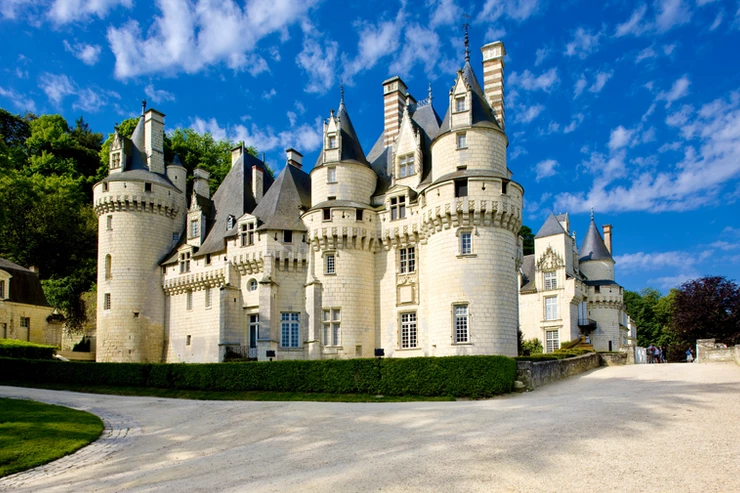
24. Chateau d’Usse
Chateau d’Usse is a beautiful chateaux in the Loire Valley chateau. It’s famous as the inspiration for Perrault’s Sleeping Beauty fairytale and Disney’s famous Cinderella Castle.
You can immediately see why. The charming chateau has a romantic turret-topped exterior.
Situated on the edge of Chinon forest, Chateau d’Usse was built for the Built family in the 15th century. The castle changed hands many times. In 1885, the Count de Blacas bought the chateau and his ancestors still live there today.
Inside it boasts dreamy spiral staircases, unusual frescos, and 17th century tapestries.
Take a stroll in the French gardens as well. They were designed by Le Notre of Versailles fame.
25. Chateau de Langeais
The Chateau de Langeais was founded in 992 by Foulques Nerra. He was an early count of Anjou and a celebrated builder of medieval castles.
The castle was destroyed during the Hundred Years’ War in the 14th and 15th centuries. It was later rebuilt by King Louis XII in the mid-to-late 15th century. It’s considered an excellent example of late medieval architecture — with crenellated battlements and pointy defensive towers.
Langeais is perfectly preserved both inside and out. Over 15 rooms, there’s original 15th century period furniture and scores of Flemish and Aubusson tapestries.
26. Chateau de Montreuil-Bellay
If you have the time and energy to squeeze in one more chateau, head to the medieval Chateau de Montreuil-Bellay. It’s about 10 miles south of the town of Saumur in the Loire Valley.
There have been fortifications on this site from the 11th century. The current chateau was built between the 13th and 15th centuries. It served a defensive purpose during the 100 Years War. When that war was over, the chateau received a Renaissance facelift and elegant additions.
The highlight of the chateau is the wine cellars. Legend holds that when the wine was made, the vintners would swear to a portrait of Rabelais: “When my glass if full, I empty it. When it is empty, I complain.”
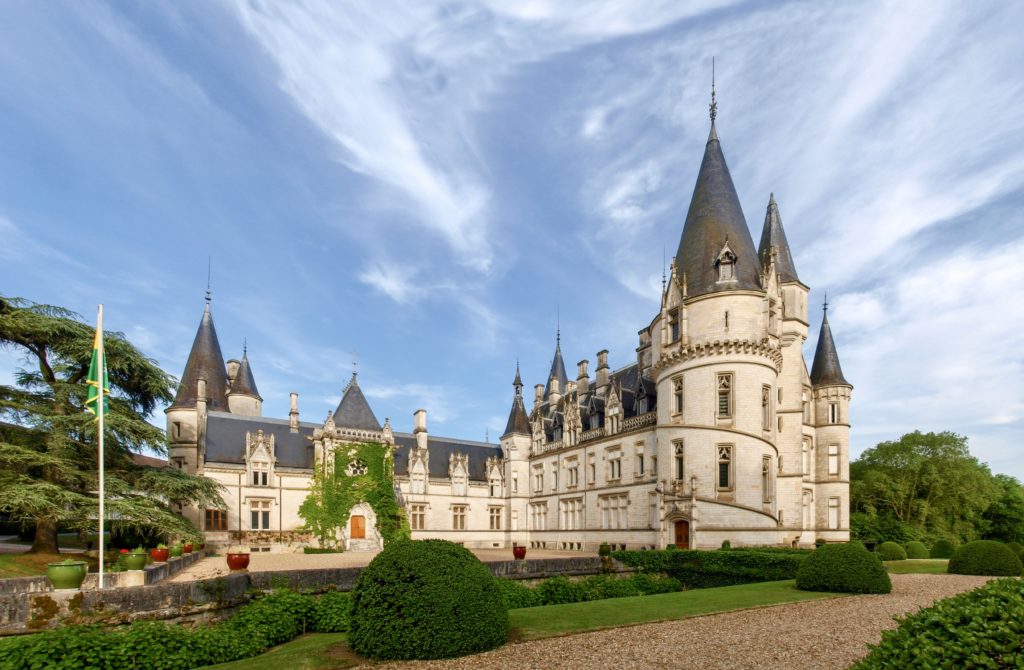
27. Chateau de Sully-sur-Loire
Chateau de Sully is another beautiful little chateaux in France. It’s a manor house with an imposing silhouette and a mysterious history.
The earliest remains of the chateau are from 1102. But the chateau you see today dates from the 16th century. Then, the chateau was owned by the Saul Tavannes family, supporters of Louis XIV.
The chateau has superb conical roofs. Inside, you’ll find elegant rooms, marble fireplaces, tapestries, paintings, priceless period furnishings, and a rather macabre taxidermy collection.
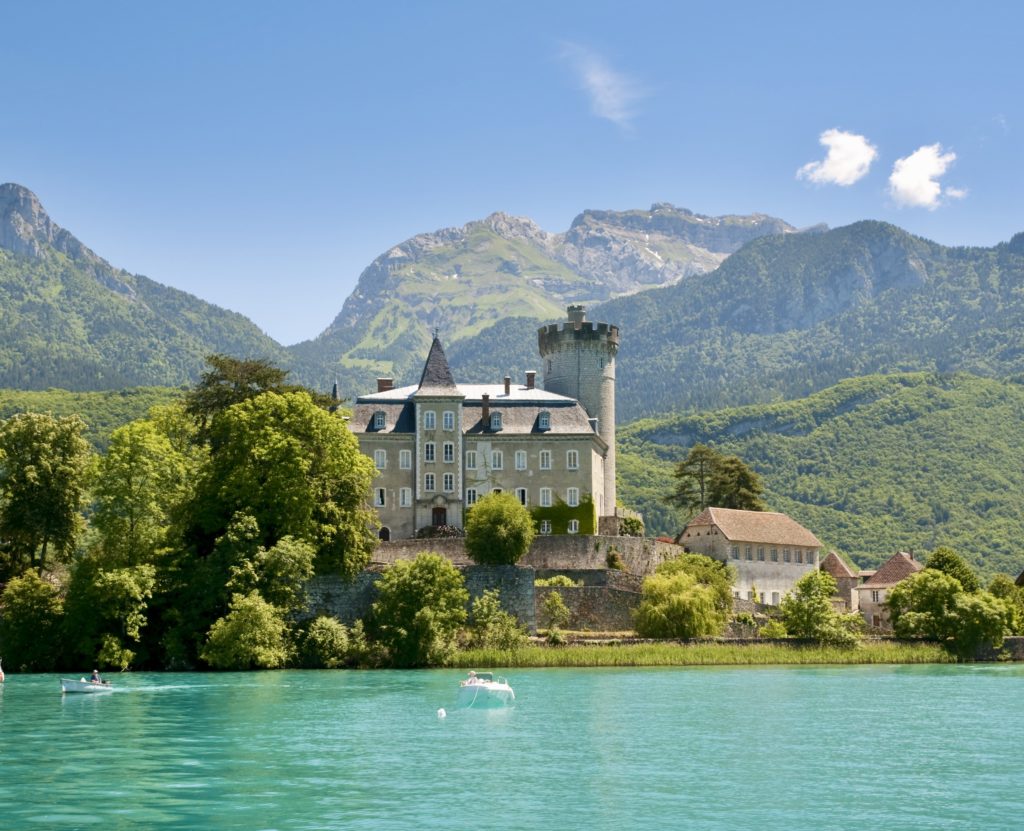
28. Chateau d’Annecy
The Chateau d’Annecy is located in the small town of Annecy in eastern France.
The castle complex dates back to 13th century. The chateau has served as the seat and residence of the Counts of Geneva and the Dukes of Genevois-Nemours.
The chateau was bought by the city of Annecy in 1953, who converted it into a museum. Today, the castle houses a collection of regional sculptures and paintings.
The terrace of the castle offers beautiful views of the town rooftops and Lake Annecy. The chateau sits on a hill and is connected to the old town center by several cobblestone alleys.
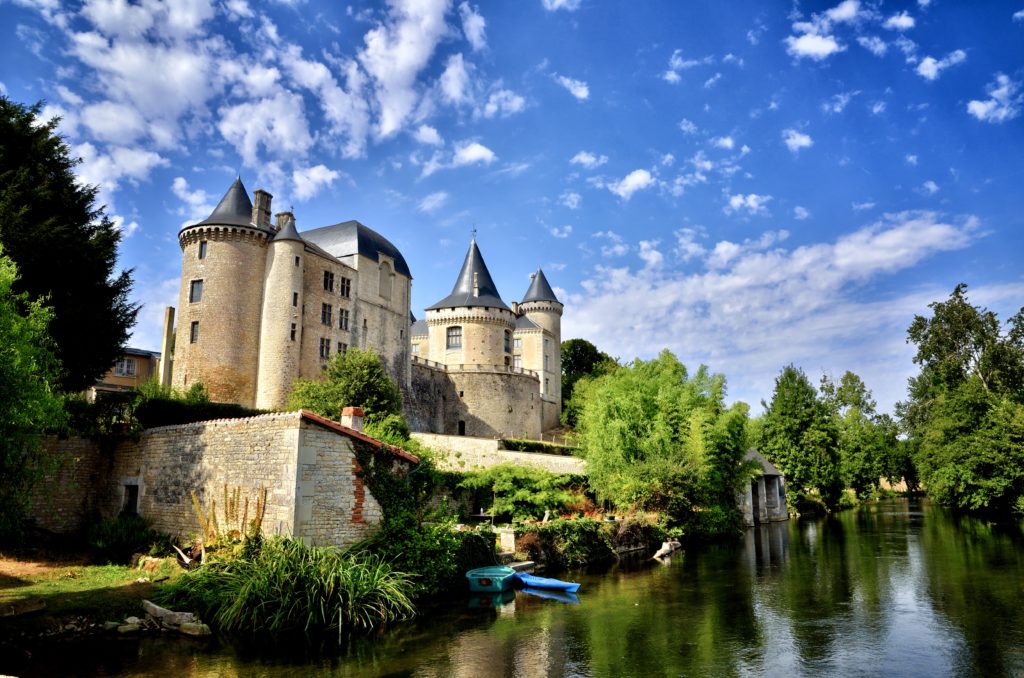
29. Chateau de Verteuil
The Chateau de Verteuil overlooks the Charente River in the small village of Verteuil in southwest France. It was first built in 1080 and has been listed as an historic monument since 2010.
Intermittent wars ravaged the castle. But it was always rebuilt in different styles. The castle boasts five conical towers, a huge library, and partially restored watchtower
The chateau is a private estate. You can only visit on a guided tour on weekend days between April and September. But you’ll get a snapshot of what life was like for the French elite.
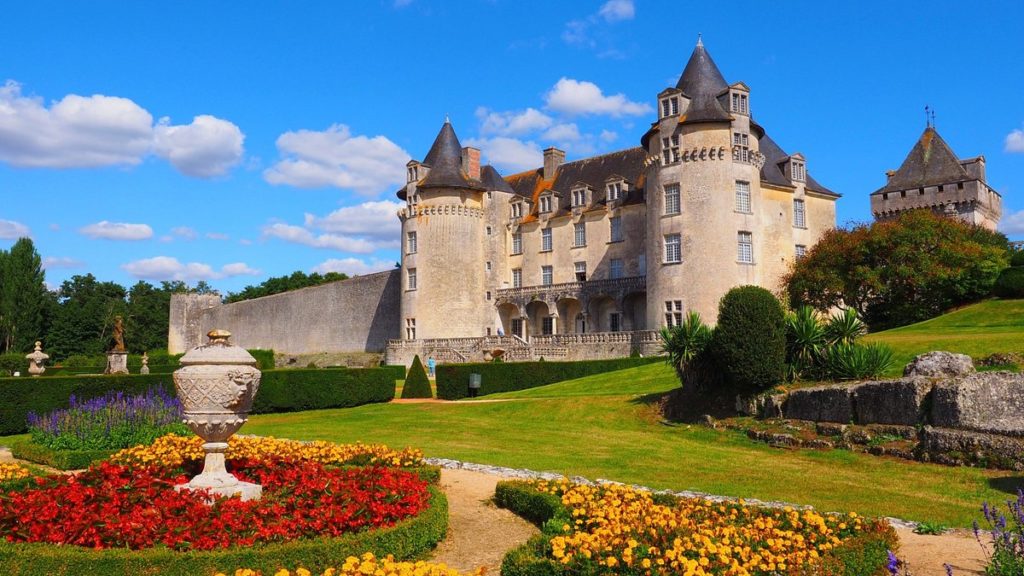
30. Chateau de la Roche-Courbon
Chateau de la Roche-Courbon was built in the 15th century as a fortified castle during the Hundred Years’ War. It’s been listed as a historic monument since 1925.
In the 17th century, the chateau was transformed into a country estate by Jean-Louis de Bourbon. The chateau was later abandoned and saved from ruin by Paul Chénereau, whose family still owns the chateau.
The interior decor dates from the 17th century. A double Renaissance staircase leads down to beautiful gardens. Underneath the chateau are caves in which prehistoric artifacts were found.
The castle can be visited with a guided tour on Thursdays.
I hope you’ve enjoyed my guide to France’s beautiful chateaux. You may enjoy these other France travel guides and resources:
- 3 day itinerary for Paris
- 5 day itinerary for Paris
- 10 one week in France itineraries
- Hidden gems in Paris
- 30+ beautifultowns in northern France
- Beautiful villages of Brittany
- Beautiful villages in Normandy
- 10 day itinerary for southern France
- Charming hidden gems in Provence
- Hilltop villages of the Luberon Valley
If you’d like to visit France’s most famous and beautiful chateaux, pin it for later.

